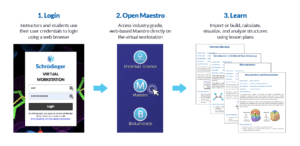Molecular modeling provides a powerful set of tools that are used in the life sciences industry to simulate molecular behavior in chemical or biological systems, making it a key component in many areas of research, including drug discovery. Although these tools would prove invaluable in STEM classrooms by allowing students the ability to visualize and interact with molecules in a three-dimensional environment, molecular modeling is rarely included in curriculums due to a number of technological barriers, including students not having enough disk space to download new software, laptops not being up to date for software to be compatible, as well as more historical barriers to science education such as cost and accessibility.
To help overcome these challenges, we have launched a new “Teaching with Schrödinger” molecular modeling program where we have made a web-based version of Maestro, our proprietary software, more accessible to educators and students around the world through a virtual desktop environment for science education. With this program, educators and students can simply log into a virtual workstation through a web browser that has Schrödinger’s core suite of software already downloaded and ready to use for learning. And all jobs are submitted to a virtual cluster.
Over the past few months, over 400 graduate, undergraduate, and high school students from five different institutions have taken part in the Teaching with Schrödinger beta test: UCLA, Oberlin College, University of Vermont, New York City College of Technology, and Jovan Jovanovic Zmaj. They tested Schrödinger’s newest educational lesson plans that ranged in topics from general and organic chemistry to molecular modeling and drug design, and the learning outcomes have been outstanding. Students learned how to build, visualize, and analyze molecular structures in a way that surpasses any traditional two-dimensional drawing in their science textbooks. In addition to using the tools themselves for science education, the Teaching with Schrödinger program provides the professors and students with lesson plans, worksheets and homework to ensure that they get the most from access to these industry-grade research tools.

We connected with two chemistry professors, Dr. Hung Pham of University of California, Los Angeles and Dr. Severin Schneebeli of University of Vermont, whose students beta tested the Virtual Cluster software. These professors shared some of the ways their students benefited from the modeling software to supplement their learning and to better visualize molecular structures.
For example, with the Virtual Cluster students are able to rotate molecules, measure bond angles and distances, and conduct additional activities that would be impossible to do with a two-dimensional image on a piece of paper. “In my organic chemistry course, students don’t always make the connection when translating 2D structure to 3D structures. So having the accessibility of using tools to turn the molecule around, rotate it and see what it looks like is really useful for them,” said Dr. Pham. “It’s cool to expose them to these tools, and it is inherently useful for them in the long run.”
Having a better understanding of molecule structures is not the only benefit for students. “It’s more interesting than just looking at a 2D molecule on a piece of paper. It’s an entirely different kind of engagement,” said Dr. Schneebeli, who likened the experience of using molecular modeling tools to playing a video game. “When I did vibrational frequencies and they could see the molecules vibrate – they really thought that was fun. I see huge potential.” The program also gives students the opportunity to work with science education tools that are having tremendous impact across the drug discovery landscape and solving major problems.
While enhanced learning and increased engagement are undoubtedly positive outcomes of leveraging molecular modeling tools with students and incorporating them into coursework, there is something even bigger at play by modernizing science curriculum: the benefit of exposing students to new forms of science that are not typically part of STEM education and that are in demand in today’s life sciences industry. “There is a huge boom now in companies looking for computational chemists, particularly for drug discovery. The challenge is that many people don’t necessarily get exposed to it in school, and I think we are missing out on students who would really like this kind of research or experience,” said Dr. Schneebeli. “ It is these kinds of tools that could broaden students’ exposure to computational chemistry.”
And it’s not just the college level that would benefit from these types of tools. Despite being a professor of chemistry to both graduate and undergraduate students, Dr. Pham sees potential for these tools in much earlier stages of science education, comparing molecular modeling to Legos. “No matter what age you are you can learn something from them and play with them, and you can treat them as a toy or treat them as a learning tool,” said Dr. Pham. “If you implement molecular visualization early on, when students are just learning about atoms and molecules and talking about bonding, students can make the connection that these are actual, tangible objects, even though microscopic. These tools can spur interest, and chemistry is one of those subjects that would benefit from more interest.”
Ultimately, at Schrödinger, our hope is for these types of tools to make an impact in the classroom starting as early as high school because we believe it is critical to invest in the next generation of scientists. Leveraging technology to better support learning, elevating science curriculums and exposing students to new career paths (like computational chemistry) is the best path forward to ensure greater interest and engagement among today’s students.
The Teaching with Schrödinger program is now available to any educator interested in integrating molecular modeling into their classroom. For more information, contact the Education Team at teaching@schrodinger.com, or visit the Teaching with Schrödinger website at https://www.schrodinger.com/learn/training/teaching-with-schrodinger.










